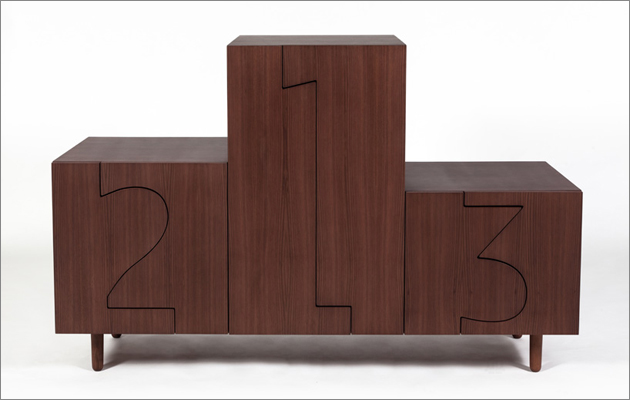|
|
||
|
The 10th edition of Design Miami Basel is taking place this week in the Swiss city, drawing together collectable designs, new commissions and a specially curated exhibition of architecture Design at Large Shigeru Ban’s Paper Tea House, Jean Prouvé’s Total filling station, the Ikea Foundation’s Better Shelter flatpack refugee home and Atelier van Lieshout’s labyrinthine Original Dwelling are part of an exhibition of demountable structures in the venue’s vast ground floor space. Curated by property baron and hotelier André Balazs and design historian Tiffany Lambert, the show is part of Design Miami Basel’s wittily-named platform for large-scale works, “Design at Large”. The modular, prefabricated structures are a refreshing contrast to the luxury, limited-edition designs on display in the fair’s main hall, and raise timely questions about the social potential of mass production. The theme continues at Galerie Patrick Seguin’s stand, where Rogers Stirk Harbour + Partners are showing a redesign of Prouvé’s 6 x 6 Demountable House as a holiday retreat, with the addition of bathroom and cooking pods, and hot water and solar power provisions. Originally built in 1944 for victims of the second world war, its inclusion in this form – for enjoyment by the elite – may grate slightly, the practice hope it will act as a blueprint for future transportable refugee housing, in keeping with Prouvé’s original vision. Designers of the Future |
Words Debika Ray
Above (clockwise from left): The Ikea Foundation’s Better Shelter flatpack refugee home, the Volkeswagen T2 Campervan, Jean Prouvé’s Total filling station and Atelier van Lieshout’s labyrinthine Original Dwelling
Images: James Harris |
|
|
|
||
|
The Designers of the Future awards return this year under the wing of Swarovski, with three emerging practices presenting new works that use crystal in remarkably diverse ways. London-based Spanish designer Tomas Alonso’s 47° has the most immediate commercial appeal – a series of trays, lights and mirrors that play with both the angle at which light refracts within a crystal and the colour of the glue that binds together separate elements. Hong Kong-based Elaine Yan Ling Ng took inspiration from the carnivorous Sundew plant for her installation: three sculptures made of crystal fabric hang within a tantalisingly sweet-scented environment, pulsating and rotating in response to the viewer. Alexander Groves and Azusa Murakami of Studio Swine used the world’s smallest precision cut crystal for their Terraforma project: an installation of sound, video and objects based around the idea of a fictional planet made entirely of crystal. Gallery Fumi |
||
|
|
||
|
The London-based gallery presented a range of designs by well-known practices. Max Lamb’s Metalware series of chairs built from brass, copper and steel tubes gleam at the front of the stand, with his colourful Urushi low table nearby, while mirrored artworks by Rete Corallina and Sam Orlando Miller cover the walls. The rest of the display includes Study O Portable’s Fuzz bench, made by applying layers of resin onto a rotating form; Glithero’s patinated bronze Les French chair and table; Lukas Wegwerth’s crystallised vessels; and a plaster bench, steel birdcage and fibreglass daybed by Faye Toogood. Jaime Hayon |
||
|
|
||
|
The designer’s sport-inspired collection is on display at the Galerie Kreo stand. Game On includes tables inspired by the markings of golf balls and basketballs, a mirror that is very literally shaped like a ping pong bat and ball and a cabinet that mimics a winners’ podium, with the numbers 1, 2 and 3 carved into its doors (pictured above). The full range can be seen at exhibitions in the gallery’s London and Paris premise, which features in our upcoming issue – out on 7 July. Olson Kundig |
||
|
|
||
|
The US-based architect designed the pavilion that hosts a restaurant that connects to the main exhibition space and a more intimate, enclosed lounge for talks and meetings. Dovetailing with the theme of the Design at Large exhibition, the modular structure is made out of wooden industrial cutoffs from eastern Europe. Light emanates outwards through the gaps between the stacked panels which were blackened using shou sugi ban, the Japanese method of charring wood to preserve it. |
||
|
Gallery ALL
For its debut at Design Miami Basel, Beijing-based Gallery ALL, which has an outpost in Los Angeles, presented works only by Chinese designers. Among these were Zhang Zhoujie, who created a digitally-fabricated collection of brass chairs, generated using parametric algorithms, and Naihan Li who presented her Crates series of homeware, as well as her Cloth Valet, a series of storage panels that fit together with metal fixings, and a mobile bar – both of which fold to form closed, mobile boxes. The gallery is one of the first to champion contemporary Chinese design, and its founder, Yu Wang, spoke at a panel discussion about the significance to design of the Pearl River Delta and the Chinese government’s efforts to promote creative sectors. Carwan Gallery |
||
|
|
||
|
The Beirut-based gallery is showing Transform, a solo exhibition of the Lebanese designer Karen Chekerdjian of limited edition objects inspired by the idea of metamorphosis: the shapes reference rock formations, plate tectonics and rainbows. Design Miami Basel ends on 21 June 2015 |
||

























